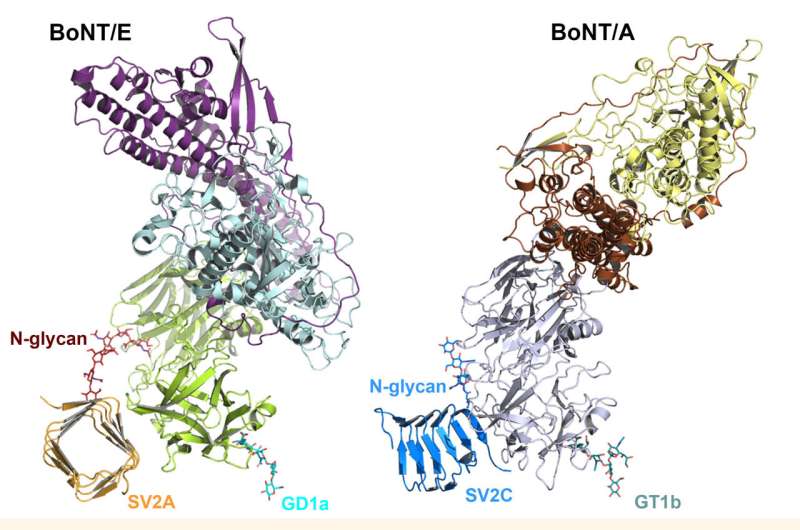This article has been reviewed according to Science X's editorial process and policies. Editors have highlighted the following attributes while ensuring the content's credibility:
fact-checked
peer-reviewed publication
trusted source
proofread
Researchers uncover new potential for botulinum neurotoxin E in therapeutic and cosmetic applications

A team of researchers from the University of California, Irvine, have revealed the first crystal structures of the receptor-binding domain of botulinum neurotoxin E (BoNT/E) in complex with its human neuronal receptors, synaptic vesicle glycoprotein 2A (SV2A). This structure and other findings in the new study could be harnessed to engineer new BoNT/E variants with modified specificities toward different SV2 isoforms for new clinical developments.
Published in Nature Communications, the study, titled, "Structural basis for botulinum neurotoxin E recognition of synaptic vesicle protein 2," reveals a novel 3D structure that shows how BoNT/E simultaneously recognizes both specific protein segments and an N-glycan of its host receptor SV2A for effective neuronal binding and uptake.
This mechanism is distinct from how BoNT/A (e.g. Botox) or BoNT/B (e.g. Myobloc) recognize their human receptors. Additionally, the team's findings demonstrate how BoNT/E is able to detect subtle differences in the primary sequences of three closely related SV2 isoforms, resulting in high selectivity towards SV2A and SV2B, but not SV2C, as its receptors.
"Since both BoNT/E and BoNT/A piggyback on human SV2 as receptors to sneak into neurons, we used to believe that they should use the same tactics. Surprisingly, our new crystal structure reveals that they, in fact, exploit distinct mechanisms to recognize SV2 for cell entry, which could partly explain the unique pharmacological and clinical profiles of BoNT/E," said Rongsheng Jin, Ph.D., professor in the Department of Physiology & Biophysics in the UCI School of Medicine.
"Our team's findings also provide new insights into how BoNT/E manages to selectively recognize SV2A and SV2B over SV2C as receptors, while BoNT/A could use all three SV2 isoforms. It suggests that BoNT/E and BoNT/A may target different subsets of human tissues and cells that express different amounts of SV2A, 2B, and 2C, which may also contribute to their different biologic properties. The new 3D structure reported here can serve as a blueprint for scientists in the field to engineer new BoNT/E variants with modified specificities toward different SV2 isoforms for new clinical developments," said Jin.
BoNT/E, together with BoNT/A and BoNT/B, are the three major causes of human botulism. Despite this, BoNT/A and BoNT/B are approved drugs for a myriad of therapeutic and aesthetic uses, including Botox, Dysport, Xeomin, Jeuveau, Daxxify and Myobloc. Due to its unique pharmacological and clinical profiles, BoNT/E has attracted growing therapeutic interests and is currently in clinical trials for indications that may benefit from BoNT/E's faster onset of action and shorter duration.
Currently, the global multibillion dollar BoNT market is almost exclusively contributed by products based on BoNT/A. Besides expanding toward treating new indications using BoNT/A, there are urgent needs to develop new BoNT products based on other toxin serotypes and/or protein engineering to broaden the therapeutic landscape. The UC has filed a patent on the use of the structural information described in this paper and in other unpublished findings to engineer BoNT/E for therapeutic and cosmetic applications.
More information: Zheng Liu et al, Structural basis for botulinum neurotoxin E recognition of synaptic vesicle protein 2, Nature Communications (2023). DOI: 10.1038/s41467-023-37860-8
Journal information: Nature Communications
Provided by University of California, Irvine




















